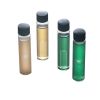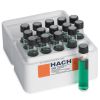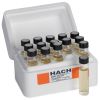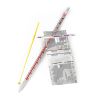Hach MEL/MPN Total Coliform and E. coli Lab
Features
- Laboratory results in the field
- Portable incubator maintains temperatures with +/- 0.5 degrees C between 30 and 50 degrees C
- Incubator power cord easily plugs into an automobile cigarette lighter
- Free ground shipping
- Expedited repair and warranty service
- Lifetime technical support
- More
Overview
The Hach MEL/MPN total coliform and E. coli lab includes a portable incubator, portable UV lamp, and consumables for 50 tests. The MPN method of analysis uses tubes that contain a broth for bacterial growth
Applications
The Hach MEL/MPN provides all the hardware to carry out the Most Probable Number (MPN) method. In addition to potable water, the MPN method is ideal for wastewater samples and nonpotable samples, because the analyst can accommodate highly turbid samples, which would otherwise require filtration.
*Media is not included (order separately - see manual on Documents tab). For wastewater applications, order dilution water 1430598.
- Portable incubator with 12 VDC power socket
- Incubator rack for MPN tubes
- UV lamp, long-wave, portable, 4 watt, battery-operated
- Battery, AA alkaline (4x)
- Thermometer, pocket, –10 to 110 °C (14 to 230 °F)
- Carrying case
- Pipet, serological, 10 mL, sterile, disposable, individually wrapped (50x)
- Pipet safety bulb
- Inoculating loops, sterile, disposable, 10 µL (50x)
- Sampling bags, Whirl-Pak with dechlorinating agent, 180 mL (50x)
- Laboratory marker
In The News
Fecal Bacteria Rises with Sea Level on Texas Beaches
As climate change lifts the sea level in the Gulf of Mexico, it’s lifting levels of enterococci bacteria on Texas’s beaches, too. New research out of the Gulf shows that high levels of enterococci bacteria, which come from humans and other animals and can cause disease, are correlated with proximity to large human populations and sea level rise and are increasing over time. The research highlights an area of growing concern for public health and safety on popular recreational beaches. While sea level is projected to continue rising, it’s not a guarantee that bacteria levels will as well.
Read MoreNational Park Dairies Curb Pollution with Best Practices
The cold Pacific Ocean waters that surround Point Reyes National Seashore support an abundance of wildlife and make for stunning views. They also generate the frequent fogs that water the grasslands that beef and dairy cows have grazed for more than 150 years. While it’s unusual for 28,000 acres of a national park to be dedicated to agriculture as it is at Point Reyes, the relationship that’s been in place since the park’s designation by John F. Kennedy in 1962. Now, research by National Park Service scientists shows improving water quality as best management practices for manure control were installed on the dairies and ranches within the park.
Read MoreGovernment Officials Ignore Health Risks Associated with E. coli in Boulder Creek
Since 2003 harmful bacteria Escherichia coli (E. coli) levels have created a health risk to recreational users in Boulder Creek. Boulder Creek has been designated as an impaired stream and is not meeting an EPA health-based water quality standard. Concentrations of E. coli increase from the mouth of Boulder Canyon to the University of Colorado-Boulder and beyond based upon data collected by the City of Boulder according to information published by the CU Independent and the Boulder Camera . EM spoke to environmental engineer Art Hirsch of the Boulder Waterkeeper , who is advocating for greater accountability from all entities that own property abutting the stream. “E.
Read More


















